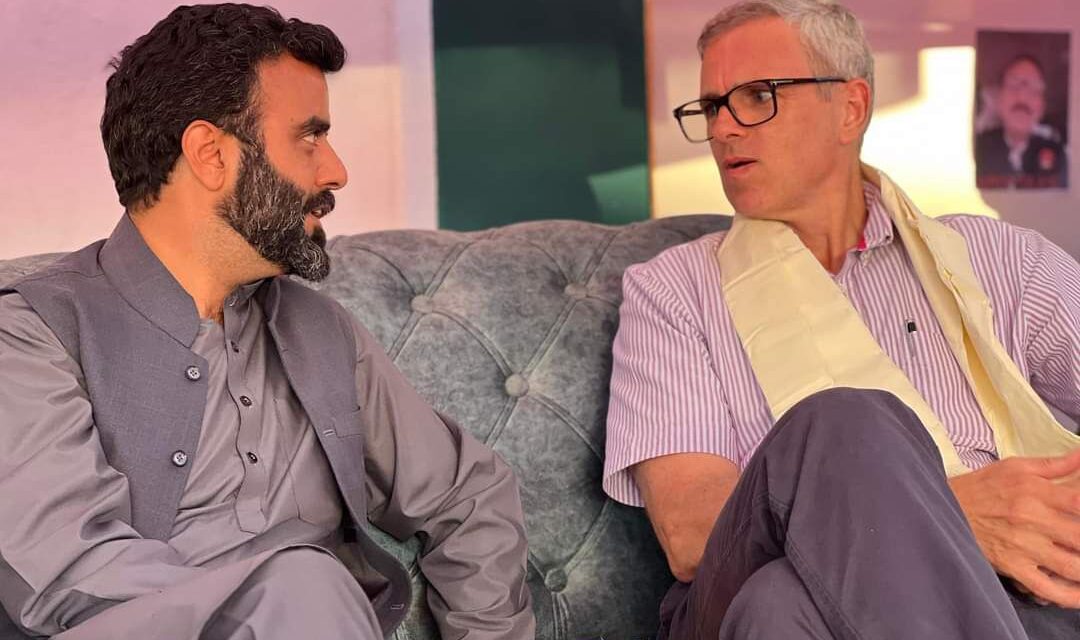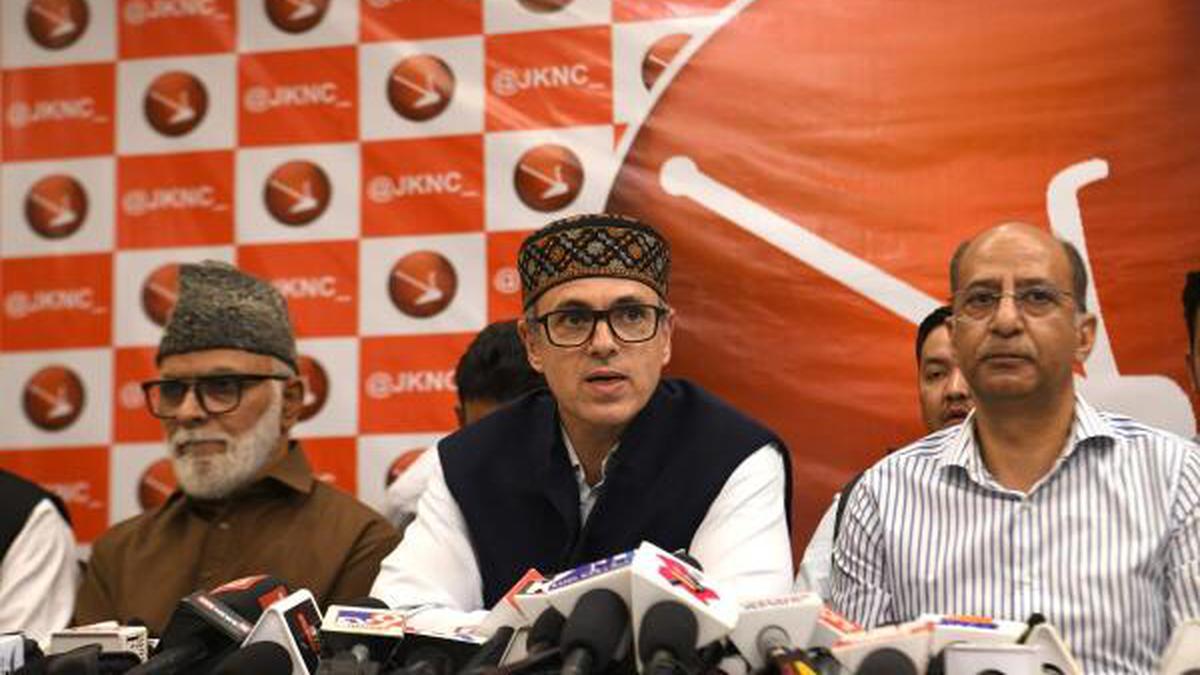Omar Abdullah and MP Ruhullah Engage in War of Words as NC Rift Widens
By: Javid Amin | 27 October 2025
When Internal Friction Becomes Public
In late October 2025, the halls of power in Jammu & Kashmir witnessed an unusually public skirmish within the ranks of the Jammu & Kashmir National Conference (NC). Chief Minister Omar Abdullah and MP Aga Syed Ruhullah Mehdi — both key figures within the party — found themselves at odds, not in closed-door meetings, but in words broadcast to the wider public.
Such open dissent is rare for the NC, which traditionally emphasises unity and collective messaging. The significance goes beyond personal quarrel: it signals deeper fissures over leadership, ideology and electoral strategy at a moment when the NC is under pressure in the run-up to the crucial Budgam by-elections.
In what follows, we unpack this rift in detail: the origins, the positions of the protagonists, the broader party context, the electoral implications and what this episode reveals about the evolving political dynamics in Jammu & Kashmir.
The Key Players: Profile of Omar Abdullah & Aga Ruhullah Mehdi
01. Omar Abdullah — The Established Leader
Omar Abdullah comes from one of Kashmir’s most prominent political families. His grandfather Dr K H Abdullah, father Farooq Abdullah — all have helmed the NC at various times. After serving earlier as Chief Minister (2009–2014), Omar returned to power in October 2024 when the NC won the Assembly election under the Union Territory arrangement.
His leadership is based on his experience, name-recognition and his role in charting the NC’s path post-2019 developments in J&K.
02. Aga Syed Ruhullah Mehdi — The Vocal MP
Aga Syed Ruhullah Mehdi, the MP from Srinagar (Lok Sabha constituency), has built a reputation as a fiery and outspoken figure within the NC. He has repeatedly raised issues of autonomy, statehood restoration, cross-voting controversies, and the perceived drift from core promises. His public posture is that of a voice of conscience and urgency.
In 2024 general elections he won from Srinagar, signalling his importance in the NC’s parliamentary strength.
The Flashpoint: What Triggered the Feud
01. The Autumn Legislative Session Outburst
The spark for the current public confrontation reportedly came during the Autumn session of the J&K Legislative Assembly, when Omar Abdullah made remarks distinguishing between senior MP Mian Altaf Ahmad Larvi and Ruhullah. He said:
“There’s a vast difference between the two… Don’t put them on the same platform.”
By praising Altaf as a “father figure” and quietly sidestepping Ruhullah, Omar signalled a preferential line—one that Ruhullah interpreted as a snub.
Ruhullah, in his response, accused the leadership of softening toward the BJP, failing to hold cross-voters accountable, and abandoning core NC promises like the restoration of Article 370 and resisting perceived central influence.
02. Budgam By-Elections & Cross-Voting Fallout
The timing exacerbates the tensions. The upcoming by-elections in the Budgam Assembly constituency (part of the greater NC’s turf) have placed strategic focus on the NC’s campaign machinery. With one of the key voices — Ruhullah — publicly disengaging from campaign efforts, internal unease has grown.
Moreover, the backdrop of the recent Rajya Sabha elections where the BJP secured a seat amid cross-voting allegations has aggravated fault-lines within the NC. Ruhullah has accused the leadership of hiding names, lacking transparency and betraying the public mandate.
03. Public Calls for Resignation
In a riposte to Ruhullah’s critique, a senior NC leader, MLA Majeed Larmi, asked Ruhullah to resign his parliamentary seat if he believed the government had failed — suggesting that persistent criticism without stepping down amounted to inertia rather than protest.
This exchange marks the conflict’s intensity — not just critique but calls for internal accountability.
The Core Issues: Ideology, Strategy and Performance
01. Ideological Drift vs. Core Promises
Ruhullah’s main charge is that the NC under Omar is drifting from its ideological roots. He has claimed:
“We promised dignity and autonomy. What we’re delivering is silence and surrender.”
“Kashmir is facing an existential crisis. This is not the time to fight personal wars or offer symbolic gifts to those who dismantled our autonomy.”
His critique resonates among those within the party and electorate frustrated at what they consider the slow pace on statehood restoration, Article 370 discussions, cross-voting accountability and perceived proximity to the BJP.
Omar and his team appear to prioritise a different calculus — managing governance within constraints (of Union Territory status, limited devolved powers) while projecting political stability. Omar reportedly told media that the NC has “enough leaders” and that individuals are free to make choices about campaigning.
02. Governance Performance and Internal Expectations
Senior party figure Mian Altaf also publicly criticised the government’s pace on jobs, youth unemployment and performance:
“There is no progress on political issues of J&K … the people in the government … will have to improve their performance.”
These criticisms underscore that the rift is not just ideological but performance-based — if promises are unfulfilled, internal pressure mounts.
Ruhullah emphasised refusals to campaign on behalf of the NC while the party cannot point to clear, visible achievements:
“My party should tell me what I should seek votes on. What have we done in the last one year regarding the people’s political aspirations? Let the party name even a single achievement — I will campaign on that.”
03. Strategic Consequences for Campaigning
With the Budgam bypoll underway, the public rift becomes an electoral liability for the NC. The absence of a major MP from campaign activities — especially one with strong grassroots appeal — narrows the party’s mobilisation capacity.
Furthermore, the internal dissent offers the opposition fodder: if the NC is publicly struggling internally, the narrative of governance faltering can gain currency. Analysts note that this is “not just routine dissent” but a signal of disconnect between leadership and key constituencies.
What Does the Public Show of Discord Reveal?
01. Internal Cohesion under Strain
The NC has long projected itself as a disciplined organisation with top-down coherence. A public feud between a CM and MP — especially one from the same party — reflects the pressures of coalition politics, the limits of leadership under Union Territory status, and the tensions between ideological legacy and present-day pragmatism.
02. Leadership and Generational Shift
Omar Abdullah, while experienced, is contending with newer voices like Ruhullah who articulate a sharper, often more uncompromising stance on autonomy and statehood. The friction hints at a generational and strategic shift — older leadership comfortable with incrementalism versus newer actors demanding a bolder posture.
03. Governance Limitation vs. Public Expectation
The rift also underscores the governance gap in J&K’s special status context. The NC government’s limited powers mean that even motivated leadership can struggle to deliver visible results. Public expectations, however, are rising — especially among youths, job-seekers and those who voted for a restoration agenda. This creates an authenticity/efficacy challenge.
04. Political Risk Ahead of Elections
For the NC, this reveal of internal discord ahead of the Budgam by-election and possibly assembly elections presents risk. Voters may interpret the infighting as neglect of the public agenda, dilution of focus, or lack of unified vision — all of which opposition parties can capitalise upon.
Scenarios Ahead: Implications for the NC & J&K Politics
01. Scenario A – Reconciliation and Internal Renewal
The NC leadership may work to contain the split: engage Ruhullah in decision-making, address his concerns publicly, and demonstrate early governance gains. A visible reconciliation might reinforce party unity and strengthen the election campaign.
02. Scenario B – Deepening Rift and Electoral Fallout
If Ruhullah remains disengaged (refusing to campaign) and internal criticisms mount, the NC could suffer in key contests. Voter perceptions of a divided party may reduce mobilisation, encourage defection or open a space for rivals. The Budgam by-poll may become a bellwether for broader party health.
03. Scenario C – Leadership Change or Factionalisation
In extreme cases, persistent dissent could lead to factionalisation within the NC, with Ruhullah or his supporters building a distinct identity. The CGovernorship might leverage internal splits. Omar’s authority within the party could be undermined if more senior figures side with the dissenters.
Why This Matters for Jammu & Kashmir’s Political Trajectory
01. Impact on Statehood & Autonomy Agenda
One of the core grievances raised by Ruhullah is the NC’s perceived passivity on statehood restoration and the return of political autonomy. If internal divisions weaken the party’s push on these issues, the broader agenda for J&K’s institutional future may suffer.
02. Youth and Voter Sentiment
The people of J&K, especially the younger generation, voted for change in 2024 — with expectations of agency, rights and economic opportunities. The NC’s ability to deliver on governance will influence whether youth remain engaged or become disenchanted, opening space for alternatives.
03. Opposition Opportunity
The internal NC fissures give other parties — regional or national — an opportunity to recruit disaffected voters. If the NC appears distracted by internal battles, opposition actors may step into the vacuum with sharper messages.
04. Symbolism of Party Unity in Kashmir Politics
In a region where politics is often intertwined with identity, stability and representation, the public image of unity matters. A party at odds with itself weakens the broader perception of leadership credibility in a restive area with high political salience.
Key Quotes & Public Statements
-
From Omar Abdullah:
“We have enough leaders in the party who are actively campaigning. Everyone is free to make their own choices.”
“There’s a vast difference between the two (senior MPs Altaf and Ruhullah)… Don’t put them on the same platform.” -
From Aga Syed Ruhullah Mehdi:
“Kashmir is facing an existential crisis. This is not the time to fight personal wars or offer symbolic gifts to those who dismantled our autonomy.”
“My party should tell me what I should seek votes on. What have we done in the last one year regarding the people’s political aspirations? Let the party name even a single achievement — I will campaign on that.” -
From Mian Altaf Ahmad Larvi:
“There is no progress on political issues of J&K… the people in the government … will have to improve their performance.”
-
From MLA Majeed Larmi (in defence of leadership):
“If Ruhullah believes the Chief Minister has failed to deliver, he should resign from his Lok Sabha seat… We made a promise for five years, not one.”
Bottom-Line: A Party, a Province, a Moment of Reckoning
The unfolding war of words between Omar Abdullah and Aga Syed Ruhullah Mehdi within the NC is more than intra-party squabble. It is a reflection of J&K’s evolving political moment: a region in transition, a legacy party grappling with constrained powers, and rising expectations among its people for meaningful agency and results.
For Omar Abdullah and his government, the message is clear: airing dissent publicly weakens the image of unity just when electoral battles loom. For Ruhullah, the posture is one of accountability, urgency and ideological insistence — but if not channelled effectively, it risks marginalisation. For the NC as a whole, this is a test of cohesion, adaptability and relevance.
As the Budgam by-election draws near, the party’s ability to reset its internal dynamics, translate rhetoric into concrete outcomes, and align messaging with grassroots sentiment could determine more than a single seat — it could shape the narrative of governance, autonomy and political identity in Jammu & Kashmir for years to come.



